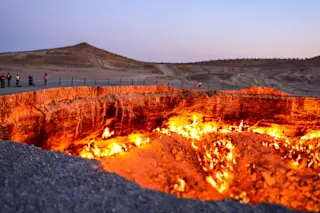This story was originally published in our Nov/Dec 2022 issue as "Burn Notice." Click here to subscribe to read more stories like this one.
The Gates of Hell has been burning nonstop for more than half a century in Turkmenistan. Also known as Darvaza, the 230-foot-wide flaming crater is fueled by a hidden natural gas reserve. Unsurprisingly, the site — situated roughly 160 miles north of the capital city of Ashgabat — has been a popular destination for the isolated country’s few tourists (and a few ultra-resilient bacteria). But that may soon change.
In January, then-President Gurbanguly Berdymukhamedov asked his government to recruit a team of experts that could extinguish the flames, citing environmental and human health concerns — as well as lost petroleum profits.
Though Darvaza’s origin is shrouded in Cold War-era secrecy, some claim that Soviet scientists ignited the crater after a drilling rig collapsed in 1971. The ...















